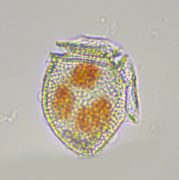
Dinophysis
- Causes Diarrhetic Shellfish Poisoning (DSP)
- Produces several toxins: okadaic acid, diniphysistoxins, pectenotoxin
- Dinophysis is a globally distributed species, with closures occurring around the country
- The first dinophysis-driven fishery closure in New England was in Maine in 2016, the first Massachusetts closure occurred in 2017
What is Dinophysis?
Dinophysis spp. is a marine dinoflagellate found worldwide in temperate and tropical waters. Individuals are between 35 and 50 μm in length, and are oval in shape with a high girdle resembling a collar around the top. There are currently 10 identified species of Dinophysis capable of producing toxins linked to Diarrhetic Shellfish Poisoning (DSP).
Major blooms in the United States have been reported in Washington State, the Gulf of Mexico, Long Island Sound, and the northeastern Atlantic Coast. Internationally, Dinophysis blooms have been identified along the west coast of Europe as well as both coasts of South America, both coasts of Africa, and the east coast of Asia. The genus is able to thrive in water temperatures ranging from the Arctic Circle to the tropics and is clearly established in the Atlantic, Pacific, and Indian basins.
Dinophysis is a mixotrophic feeder, meaning it obtains resources partly by preying on another predatory plankton species, Mesodinium, but also performs photosynthesis by integrating the chloroplasts of the prey they consume. Mesodinium feeds on a phototrophic group of plankton, the cryptophytes, which places Dinophysis as the top predator of this three-tiered ecosystem in the water column. Dinophysis itself is consumed by filter-feeders, frequently shellfish.
In the course of its regular life cycle, Dinophysis naturally produces three types of toxin: okadaic acid, dinophysistoxins, and pectenotoxin. The proportion, concentration, and toxicity levels vary by species and region, but okadaic acid and dinophysistoxins are linked to a syndrome called Diarrhetic Shellfish Poisoning (DSP). The filter-feeders that consume Dinophysis accumulate and concentrate these toxins in their tissues; when toxic Dinophysis is in the water column at even low concentrations, the shellfish become toxic for humans that consume them.
DSP is not fatal, but causes severe gastrointestinal distress. Symptoms of DSP include diarrhea, nausea, vomiting, and abdominal pain, beginning between 30 minutes and a few hours after consuming the contaminated shellfish and resolving within three days.
What is the history of Dinophysis in New England?
Shellfishing closures for DSP have occurred around the country, previously concentrated on the coast of Washington and the Gulf of Mexico, including Alabama and Texas. New York began to close shellfishing for high concentrations of DSP toxins in 2010, and in 2016, the first DSP closure in New England waters took place off the coast of Maine. In 2017, Massachusetts registered the first closure for DSP in the Nauset Estuary system. Maine had another closure in 2018, from May into August, and Massachusetts imposed a precautionary closure in July 2019, though toxicity levels remained below the quarantine threshold.
Resources and References
Database
Harmful Algal Information System (Harmful Algae Event Database (HAEDAT)
Fact Sheet
Books and Research Papers
Shumway, S. E., Burkholder, J. A. M., & Morton, S. L. (2018). Harmful algal blooms: a compendium desk reference. Hoboken, NJ, USA: Wiley Blackwell.

